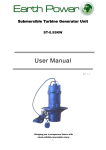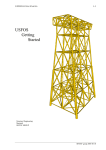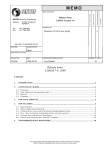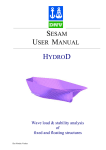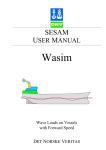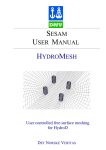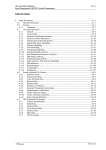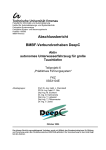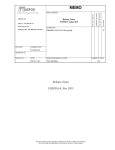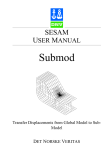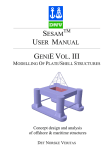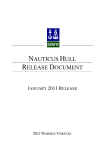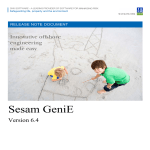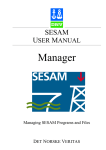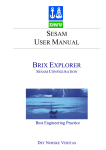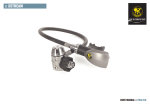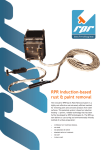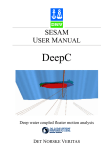Download Sesam March 2007 CD Release Notes
Transcript
SesamTM 2007 March DVD Release Notes Page 1 The SesamTM 2007 March release makes analysis faster and easier DNV Software is proud to release an updated version of Sesam including new versions of the industry-leading software tools GeniE, HydroD and DeepC. “The new enhancements make analysis of offshore structures faster, easier and more reliable,” says Ole Jan Nekstad, Product Manager of Sesam. GeniE, HydroD and DeepC make up a state-of-the art complete toolbox for the engineering of fixed and floating structures. Enhancements have now been implemented with a focus on making analysis of moored floating structures easier with a higher degree of data quality. “Additionally, the modelling tools have been made much more efficient and easy to use, the need for remodelling has been minimised and there is seamless integration between the different software tools,” explains Ole Jan Nekstad. Together with the new and efficient capacity checking and the existing capabilities for analysis of fixed structures, Sesam has become a complete and modern tool for efficient engineering of offshore structures. The Sesam 2007 March release contains many and significant improvements to several Sesam programs. For each program there is a detailed description of new features available in the updates section of the Sesam support site - contact us if you require a password to access these pages. The Sesam 2007 March release contains both new program versions and updated user manuals. The major improvements that will help our users become more productive in their daily work are described in the following. Please contact your focal point in DNV Software if you would like access or test out the new features if they are not already covered by your maintenance agreement with us. 1. A new installation program Installing the Sesam 2007 March release will create an icon for starting Sesam (from the Brix Explorer for Sesam) on your desktop. Individual Sesam programs can be started from your Start menu or from your Windows explorer (default installation directory is C:\Program Files\DNVS\Sesam) – from here you can make your own desktop icons. We have made MSI packages for the various components on the Sesam 2007 March DVD. This is Microsoft's recommended technology for software deployment and it will ease the installation if you do remote-controlled deployment within your organisation. Furthermore, the installation will be done based on the so-called "All users" profile, i.e. the Sesam 2007 March DVD will install all the programs for “All Users”. This means that an administrator may perform the installation, while a user with more limited privileges (but minimum "Power User") can execute. It also means that an engineer may log on to any computer having the program installed and run it without the need for having administrative user rights. The Sesam 2007 March release has been tested on Windows XP and Windows 2000. We have also tested several (but not all) Sesam programs on a 64 bit XP machine - this testing showed no problems. Some of the programs were GeniE (including Sestra) and HydroD (including Wadam). All programs can be run on PC’s where the license control is based on USB dongles. It is required that the current license server (part of this DVD or the 2006 January CD) has been installed. The DVD also contains previous releases of Mimosa (the 3 DOF version) and Platework (supporting DNV Class note 30.6 and latest version of Sestra result files). © Det Norske Veritas AS. All rights reserved 30 March 2007 SesamTM 2007 March DVD Release Notes Page 2 1.1 Special information for users that have not installed the programs themselves If you have not done the installation yourself there are two important things to notice: Before running HydroD and DeepC for the first time you should execute the files HydroD_V2.106.reg and DeepC_V3.1-02.reg. This is necessary for the online Help function to work properly. The files are located in the directories where the programs are installed (default: C:\Program Files\DNVS\HydroD and C:\Program Files\DNVS\DeepC). If the programs are not installed in the default directory the .reg files must be edited to contain the correct paths before they are executed. The files are executed by double-clicking them. In Brix Explorer the user must be registered in the database. This is done by starting Brix Explorer and then selecting the Ongoing Jobs entry from the Navigation bar. 2. Brix Explorer The first version of Brix Explorer configured for Sesam was provided last year on the Sesam 2006 January release. Based on the experiences from a year’s usage we have updated the tool to become even more user friendly and efficient in modelling and executing Sesam projects. Among the new features are: • • • • • Extended functionality including for example Delete Jobs, Dynamic update of Documentation list and Template Description with tool-tip behavior More intuitive user interface that will allow for Clean up of Ongoing Jobs, Create Job Views and improvements in tabs for Input & Output Files Better and more intuitive file handling; typically Simplified terminology, Copy/Move option on file transfer and Download/Upload buttons for testing Workflow modeling improvements; e.g. add activity after selected activity and enhanced controllers Workflow execution improvements; e.g. skip activity in ‘Run Hierarchy’ by setting its status to ‘Suspend’ and enhanced stability If you are running an existing project that is based on the Sesam Manager, you may want to make your own desktop icon for easy access. © Det Norske Veritas AS. All rights reserved 30 March 2007 SesamTM 2007 March DVD Release Notes Page 3 3. GeniE for fixed structures Code checking of beams has traditionally been performed in Framework. We are now in the transition process to move code checking into GeniE. The new release allows for code checking according to API/WSD and AISC/ASD (the 2005 edition). The code checking and computation of code check forces are much more intuitive and engineering oriented than previous implementation in Framework – it is now also possible to do code checking of straight 3 noded beams. All our clients with valid maintenance agreements on Framework and GeniE will receive the rights to perform code checking in GeniE. The reporting capabilities have been significantly improved and it is now possible to make customised reports that can be re-used even for new projects. This means that you can do redesign of your models and automatically produce same report as before but with updated results. The user is also in full control of which colours are used for presenting e.g. usage of section properties. The new colour coding schema comes with default settings, but allows for changing the colour for any property. © Det Norske Veritas AS. All rights reserved 30 March 2007 SesamTM 2007 March DVD Release Notes Page 1 The enhancements for curved structure modelling and improved meshing make complicated modelling tasks of e.g. 3D tubular or plated joints much easier compared to previous functionality inside Sesam or competitive products. Such models may be separate models or integrated with the rest of the structure. The help system contains new tutorials on code checking and how to efficiently create models for tubular or plated joints. 4. GeniE for floating structures Since June 2005 significant resources have been spent on implementing features for more efficient modelling of floating structures (both ships and offshore floating structures), the integration with rule based loads for bulk ships (CSR – Common Structural Rules) and data transfer to HydroD (Sesam’s tool for hydrostatic and hydrodynamic analysis). The modelling capabilities have been extended to cover complex geometries like corrugated bulkheads, bulbs and spheres. Compartments are automatically created from volumes – these may be loaded with the rule loads from CSR, filled with liquid or solid content or they may be used as reference when applying a surface load (of any type). All in all, this leads to significant savings in man-hours compared to other modelling tools. The compartment definitions are automatically transferred to HydroD where ballasting may be performed. Plate modelling is now using tolerant modelling – this leads to models with better topology and hence improved finite element mesh. The new meshing capabilities will always produce a finite element model and there are several methods for user control of the mesh. Examples of such are removal of internal vertices and edges that often appear in complicated structure details. These features allow the user to model exactly the structure with very close proximities and yet obtain proper mesh for coarse or detailed analysis. Examples on how to control the mesh may be found from GeniE’s help pages. Floating structures normally use different section properties for stiffeners than fixed structures – as a consequence we have implemented additional section libraries for e.g. Holland and T-profiles. In total there are some 4000 section profiles to pick from in addition to user defined profiles. The fabrication method may also be specified to make the code checking easier. © Det Norske Veritas AS. All rights reserved 30 March 2007 SesamTM 2007 March DVD Release Notes Page 2 There are also new tutorials explaining how to make models for e.g. local analysis of a crane pedestal and global/local models of semi-submersibles. 5. HydroD for stability analysis and improved ballasting Since the last release of HydroD new features have been implemented for stability analysis and improved ballasting of compartments. This means that both hydrostatic and hydrodynamic tasks can be carried out in HydroD using the same model input from GeniE. Significant savings in manpower resources are achieved because of much less modelling time as well as reduced probability for inconsistencies between the various tasks to be performed. Some of the new features include computation of GZ-curves with and without deck tanks for offshore floaters, automatic computation of rotation axis and connecting flooding openings to compartments. The stability rule checking may be performed according to MARPOL, IMO (general ships and mobile offshore units), IBC, IGC and Norwegian Maritime Directory (mobile offshore units). The wind forces may be computed using a wind profile acting on an effective wind area that will change depending on the draft and heel/trim angle (as an alternative to a specified wind moment). It is also possible to do automatic ballasting of several compartments at the same time by using three filling fractions. The equilibrium and ballasting computations are part of the basic version of HydroD. There are also new tutorials for stability and hydrostatic analysis of barges and semi-submersibles. 6. Undo & redo functionality in DeepC The undo & redo functionality as implemented in GeniE has been very well received by our users. The same functionality has been implemented in DeepC. The new version of DeepC allows reading of all results attributes in one operation – previous versions required one attribute type each time. It has also been easier to switch between different result views, typically there is a new view that focuses fatigue of lines only. 7. Wasim The meshing functionality inside Wasim has been improved so that it is easier to model complex geometries (as e.g. shown in picture). It has also become more efficient to work with parts close to the waterline because there are new part types (surface piercing with no waterline), automatic sorting of parts along the waterline and the ability to avoid triangles on free surface at part intersection. © Det Norske Veritas AS. All rights reserved 30 March 2007 SesamTM 2007 March DVD Release Notes Page 3 Another new feature is the option for pressure handling on elements intersecting free surface. The user may now choose to compute the correct force on the panel (this used to be the option in previous releases) or the correct pressure. The program also supports the DNV Class Note 30.7 by having an option for pressure reduction (i.e. pressure modification around waterline) for frequency domain analysis. The size of the domain for pressure reduction is defined by the user. More and more we see the use of Wasim for offshore structures with no forward speed. As a consequence Wasim has been enhanced to account for a mooring system by using an additional 6x6 damping and restoring matrix. These additional matrices can also be used to model various motion control systems both with and without forward speed. 8. Framework The wind fatigue module has been improved to include fatigue of bent cans. When using the Norsok standard for code checking of beams this is now based on the N-004 Rev. 2 from 2004. 9. Sestra For many years it has been possible to manually specify the available memory in the input for Sestra. The new version will detect the available memory for the actual computer and utilise it when using the multifront solver. The benefits are reduced execution time, and for large models significant savings may be achieved. The auto detection of available memory is also highly relevant when Sestra is executed on a workstation or PC with multiple CPUs. Sestra can automatically utilise more than 1 CPU and is thus well suited to make the best out of hardware with multiple CPUs. 10. Submod Submod is updated with improved searching in global model as default. For the user this will eliminate the need to use a small tolerance to achieve a good match between the sub-model and the elements in the global model. This will also solve the problem with different (normalised) coordinate tolerance in a shell plane and out-of-plane (thickness direction). The new version of Submod is also significantly faster when using the new binary search function. For reference models we have seen speed up factors of up to 500. The loadcase names as used in the global model will now be used in the sub-model also. © Det Norske Veritas AS. All rights reserved 30 March 2007 SesamTM 2007 March DVD Release Notes Page 4 11. Stofat The user may now select to save or not save analysis results of the run. When results are not saved the user still has an option to create a vtf-file (for viewing in Xtract) or a print file by activating a new feature in the run analysis parameters. Stofat will also estimate the space required for saving the analysis data. If the capacity of the data base is exceeded, the execution is stopped and the number of elements that can be included in the run is listed. 12. Xtract The stresses of shell, plate and membrane elements may be transformed to a user defined coordinate system. The transformation is limited to being a rotation about the surface normal. It is also easier to define sets (multiple options) and also to select multiple sets by using e.g. Ctrl+click or Shift+click. When viewing one set(s) it is possible to include rest of the model using dashed lines. 13. Usfos The introduction of the graphical user interface for analysis control and post-processing of results made analysis tasks in Usfos much easier – these features have now been improved. The interaction with Sesam has also been improved; typically named sets as defined in Sesam will be the same in Usfos. There are also additional new functionalities like for example non-hydrodynamic elements and performing buoyancy calculations using a pre-defined fill history. 14. Mimosa When upgrading to version 6.2 (the “6-DOF version”), some of the macros and commands where modified compared to version 5.7 (the “3-DOF version”). These are documented in the updated user manual for Mimosa. If you want to use a macro from an old project in the new version, you should consult the user manual to ensure compatibility. It is also possible to use a numerical wave spectrum as compared to the previous options. ----- o ----- © Det Norske Veritas AS. All rights reserved 30 March 2007







